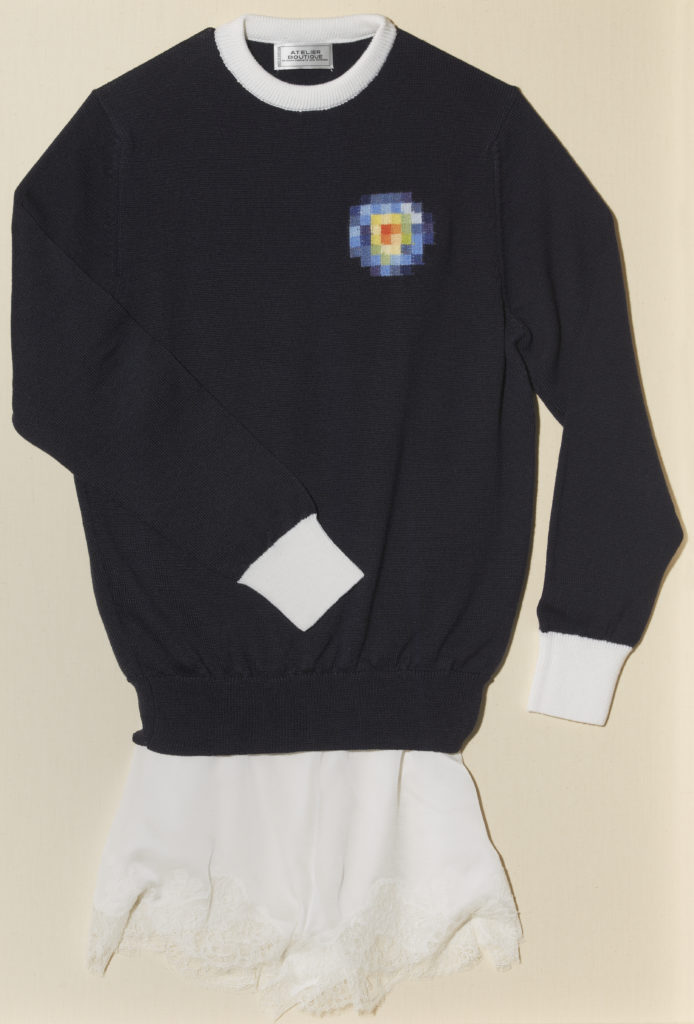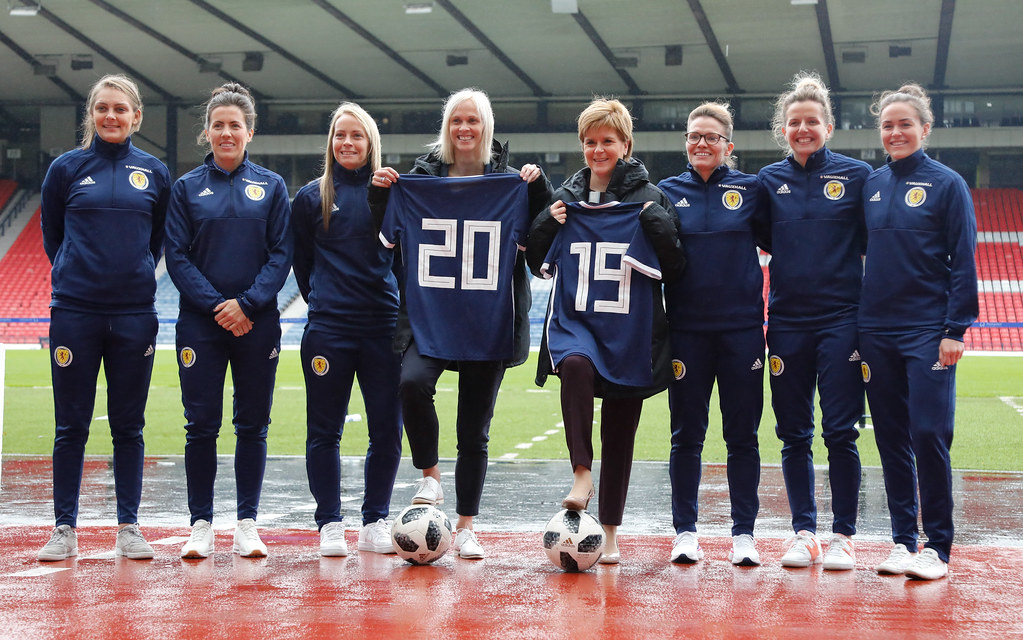
For many years the most enduring image of Scottish women’s football came from Gregory’s Girl (1980), a touchstone of 1980s Scottish cinema and popular culture, in which schoolgirl Dorothy (Dee Hepburn) overcomes sexism by proving her skills on the field and replaces Gregory as centre forward in the school team.
The inspiration behind Dalglish Jumper, former footballer Kenny Dalglish, was Scotland’s most successful player who also enjoyed a lengthy and triumphant career playing for Liverpool. In England, Dalglish was acknowledged as a leading talent who contributed to Liverpool’s national and international success in the 1970s and 1980s. In Scotland, the reverence for Dalglish was even greater as he attained the highest number of caps and quantity of goals playing for the national team.
Dalglish is a man of few words, something of a sporting cliché, and like Dorothy preferred his tremendous skill on the pitch to speak for itself. This left a certain space around the man, not simply the aura of stardom but a zone in which his admirers could project their own feelings and values.
It is a similar space in which Atelier E.B operate, whereby ‘the complex narratives that create each collection are expressed in different ways, leaving the wearer to imprint their own story onto the clothes.’[i] The fashion industry is often dismissed as luxurious yet meretricious, an accusation increasingly levelled at the art world. In working between both of these realms, Atelier E.B’s research-based artistic practice unpicks the hidden histories and signifiers of fashion, to create products and material exhibits that provide intellectual and visual stimulation. These are not mutually exclusive, providing entry points for different audiences, in opposition to art and fashion’s ‘gatekeeper’ exclusivity.
The apparently superficial is undercut by a rigorous and ethical approach to research, materials, fabrication and display. In their examination of sportwear, gender issues are analysed in ways fashion commerce markedly fails to address, and sporting history draws us into larger social histories.
Examined from a feminist viewpoint, archival research allows the artists to reveal hidden histories, especially the stories of marginalised women.[ii] The outfit is not merely a passing nod to the habits of young women for borrowing items of their boyfriend’s clothes. Lucy McKenzie has made clear that the design and reference to sports clothing in the work of Atelier E.B is concerned with its emancipatory qualities and with the rise of sports formerly derided or supressed by men such as women’s football, effectively banned in 1921, the Football Association stating ‘…the game of football is quite unsuitable for females and ought not to be encouraged.’ [iii] This repression was not lifted for 50 years, after which the sport struggled for acceptance and finance. McKenzie views the lack of support as a ‘silent norm’ whereby women’s pursuits are regularly curbed by the male establishment. [iv]

As artists and designers working and subverting within the worlds of fashion and fine art, Atelier E.B are intensely aware of the importance of display, as seen in exhibitions such as Faux Shop (V&A Dundee, 2020). They have turned their backs on the clichés of catwalks and collection shows to examine more neglected, quotidian areas of display. Far from confirming banalities or retro-ironic indulgences, their forensic research reveals new histories of window-dressing, mannequins and retail display, relishing the craft and skills that were involved and appealing for recognition for the unseen workers who attempted to create attainable dreams on the high street.
When Dalglish Jumper was included as part of the group show Rik Wouters and the Private Utopia, (Mode Museum, Antwerp, 2016), the overall installation was intended to resemble a teenage bedroom. The jumper was housed within a glass frame (as is the version in the Boswell Collection), bringing with it connotations of sports bars and domestic display, and was also signed by the artists to further emulate autographed sports memorabilia, the mark of authenticity that raises the mundane and average to a position of covetable value, appealing to the instincts of adult collectors just as Panini football stickers are attractive to children.
The artists chose to frame these works for practical reasons, to aid conservation and maintain some degree of control over how the work is presented, the nature of display being a core research interest of the partnership. In the context of fine art, the signature carries its own mark of authorial fidelity, unsigned works routinely being the subject of curatorial investigations and contested provenance. In this case, the lack of signature reflects what Lipscombe refers to as ‘tiny tweaks’ that Atelier E.B employ to tip the finely balanced references within their work one way or another. [v]
Likewise, Dalglish Jumper encapsulates a feminist challenge to the balance of power within a male dominated society. Sly humour mocks the man’s football strip by replacing shorts with frilly knickers, while what undermines masculinity flatters the female body in both form and sensuous material. Although the top is not designed to be worn on the pitch it maintains the utility of sportswear off the field, just as gymwear is as likely to be seen in the home or street as in a yoga class. Women’s reassigning of masculine clothing through stylistic appropriation is part of an evolving expansion of women into the male realm. Atelier E.B recognise this process of assimilation as an opportunity to lift the bonnet of fashion and examine the machinery beneath, to rejoice in process and detail, to pivot between sleek exteriors and intelligent interiors, the attractive and the hidden, and produce clothing and accessories that women want to wear. Through their process of interrogation of histories, techniques and gender politics, a set of propositions emerge in material form. It is the artists’ flexible, non-didactic approach that allows their audiences/customers to engage with the work at any level, whether a magazine reader, retail shopper, or a museum visitor, a feminist inclusivity that spans the perceived gap between art, fashion and sport – knitters, knickers and kickers. As the character of Susan (Clare Grogan), Gregory’s eventual date at the end of the film explains, ‘It’s just the way girls work. They help each other out.’
[i] https://www.ateliereb.com/about-atelier-e-b/ [accessed 19 October 2020]
[ii] See Laura Gardner, ‘Social Fabric / Atelier E.B.’ Flash Art Online, 17 January 2017 https://flash—art.com/2017/01/social-fabric-atelier-e-b/ [accessed 19 October 2020]
[iii] Lucy McKenzie, ‘How do you know it’s a costume?’ https://www.ateliereb.com/texts/how-do-you-know-its-a-costume/ [accessed 19 October 2020]
[iv] Ibid
[v] Beca Lipscombe in conversation with the author, 16 October 2020
Author Details:
Andrew Demetrius is Visual Resources Curator at the School of Art History, where he is also researching a PhD project, The Public Art of Glenrothes and David Harding.